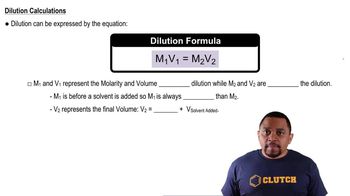Here are the essential concepts you must grasp in order to answer the question correctly.
Buffer Solutions
Buffer solutions are mixtures that resist changes in pH when small amounts of acid or base are added. They typically consist of a weak acid and its conjugate base or a weak base and its conjugate acid. In this case, NaHCO3 (sodium bicarbonate) acts as a weak acid, while Na2CO3 (sodium carbonate) serves as its conjugate base, creating a bicarbonate buffer system.
Recommended video:
Henderson-Hasselbalch Equation
The Henderson-Hasselbalch equation is a mathematical formula used to calculate the pH of a buffer solution. It is expressed as pH = pKa + log([A-]/[HA]), where pKa is the negative logarithm of the acid dissociation constant, [A-] is the concentration of the base, and [HA] is the concentration of the acid. This equation highlights the relationship between the concentrations of the acid and base components in determining the pH.
Recommended video:
Henderson-Hasselbalch Equation
Dilution and pH Stability
When a buffer solution is diluted, the concentrations of both the acid and base components decrease proportionally, but the ratio of [A-] to [HA] remains constant. As a result, the pH of the buffer solution does not change significantly upon dilution, even if the volume is increased. This property is what allows buffers to maintain a stable pH in various conditions.
Recommended video:
 Verified step by step guidance
Verified step by step guidance

